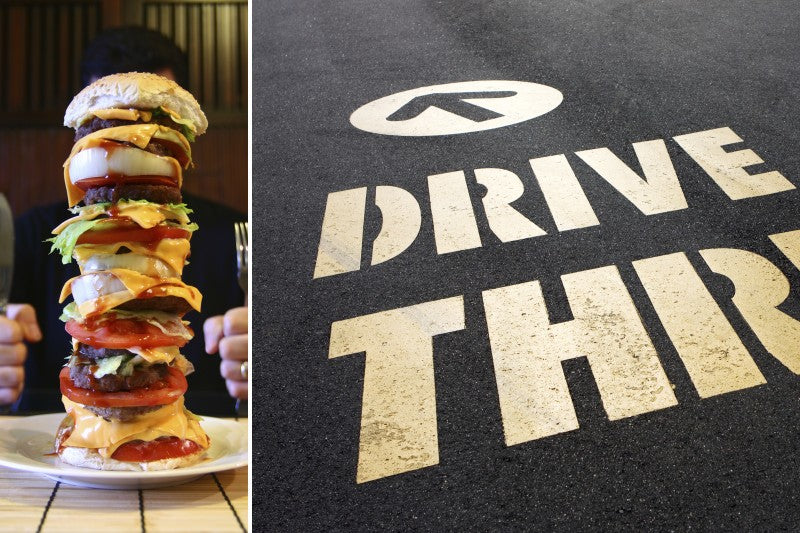
6 Diet Traps That Sabotage Your Results
It's evident. Everyone knows what good foods are and what bad food is. I can bet you know that curly fries with buttermilk ranch dressing that is magnificently paired with the double western bacon cheeseburger and washed down with a sweetened raspberry iced tea 3-4 times a week isn't optimal for your health, much less your physique, right?
But what about the lesser known traps sabotaging your results that could be showing up in your daily diet and behavior? These pitfalls are the invisible margin that can get the best of you when you aren't aware of them.
What follows are 6 diet saboteurs that can wreck your physique in a hurry, unless you beat them with the bulletproof solutions below.
Trap #1 - You're a Mindless Eater

Set down the remote, turn off the TV and focus on the meal itself. Mindless viewing leads to overeating.
Being aware of your eating is your first, and often the biggest challenge to realize. You could be derailing your diet and not even know of it.
There are two important aspects to eating with awareness. The first is eating exclusively, which means when you eat, do nothing but eat. No Instagram. No TV. No Gaming.
Studies show that eating while watching television causes people to make poor food choices and also overeat. [1] On average, Americans watch four hours of TV a day. Ok, maybe you read that and said, "I don't even have a TV, so this doesn't pertain to me."
Well, maybe you don't, but maybe your TV is YouTube, Facebook, and Netflix that you view from your laptop, tablet or phone. While the literal behavior of watching TV doesn't cause the weight gain, you're more likely to become distracted and lose track of how much you're actually consuming, which easily leads to overeating.
The second aspect of mindful eating is to eat slowly. We're rushed, distracted, and live busy lives. This leads to 5-minute meals that you scarf down so fast you can't even come up for a breath. When you eat slowly, you digest your food better, and you maintain or lose weight more easily. [2] Most importantly, it gives your body time to recognize that it's full. It takes about 15-20 minutes for your brain to send out a signal of satiety.
Solution: Make it a priority to make mealtime just that; a time to focus on the food you're eating. Enjoy it. Be sure to eat your meal at the table, or in the break room, not on the couch or in front of the computer.
Trap #2 - You've Fallen Prey to Portion Distortion
On average we eat about 500 more calories per day than we did in 1970. A large contributor to that is convenience. The explosion of fast food accessibility has caused 1/3 of Americans to get their calories from fast food. Fast food portions in the last 7 decades have quadrupled in size. The average American adult is 26 pounds heavier too. [3]While dining out may be super convenient, it comes at a cost. Studies show that the more we eat out, particularity at the fast food spots, the higher our percentage of body fat and the more we weigh.
Solution: Be your own chef. This is the best way to control your portion sizes. By prepping your own meals, you have total control of your intake.
If you don't have time, do everything you can to make time. If you manage to make time to exercise 3-5 times a week, workout less and invest that time into grocery shopping and meal prepping. An option that works for some people who are pressed for time is to hire someone to prep your meals for you.

Fast food portions in the last 7 decades have quadrupled in size. The average American adult is 26 pounds heavier too.
Trap #3 - You Shop on a Whim (And When You're Hungry)
When you go to the grocery store with no plan (and when you're hungry), you're walking into a trap. When you make purchases at the grocery store based on stimulus instead of choosing an item off a list, you're far more likely to grab that frozen pizza, a bag of family size Doritos and a 6 pack of Klondike bars.Grocery stores know what they are doing. They are marketing geniuses. They design their stores to overpower your senses. So when you're borderline "hangry" and your blood sugar levels are dipping fast, and you walk into the store without a plan or detailed list, you're guaranteed to walk out of there with items you never intended to buy.
Solution: Plan your week of meals and the items you need to make them before you head to the store. Also, have a satisfying meal before you hit the grocery store. This will help you fend off the urges to buy too much junk food.
Trap #4 - You Think it Needs to be Horrific
You've had enough and you can't take it anymore.You've got to change and lose the extra 33 pounds you've put on over the years. Somewhere along the line, we've been conditioned to believe that getting in shape and improving our health has to be a horrific experience.
You immediately eliminate any kind of pleasure from your diet. You eat food that you can't get down unless you plug your nose or wash it down with a gulp of water. You isolate yourself from any kind of social event.
The first few weeks you feel an entitlement of accomplishment. You're on a mission to change. Then the ravenous food cravings and hunger kick in. You sit there and look at your Tupperware of food and feel deflated. But for some odd reason, a voice in your head says that because your fat loss experience is horrific, you're making progress. After all, this is what it takes to burn the fat right?

Don't turn eating into some sort of horrific, minimalist ritual of deprivation. You CAN eat more than plain chicken and broccoli.Solution: You might think that dieting must be horrific in order to be successful, but that's not true at all. Don't be mistaken, burning fat will require some work and mild hunger is a part of the process. But the goal should always be to burn fat while keeping your calories as high possible by including foods that you already love.
Nobody can eat boiled chicken and steamed broccoli all the time. Eating as much as you can (both calorically and variety wise) while utilizing the minimum effective dose of exercise is the optimal way to burn fat. If you aren't versed in exercise nutrition or willing to learn it, invest in a coach who understands this.
Trap #5 - You Place Too Much Faith in Super Foods
There always seems to be a new "super-food" coming out right?
we've all seen and heard ads for the miracle root or magical pill that will automatically burn the fat right off your body. Better yet, this super-food has the ability to help you burn the fat with no effort on your part at all. You don't have to do a thing except take this pill, wear this patch or sprinkle it into your water and "voila" your new body is delivered.
It sounds great, doesn't it?
No time to prepare and eat your veggies? Machine Greens plus multivitamin allows you to drink your veggies in one convenient shake.[/caption]
Only it's not true. No matter how bad you want to believe it.
Don't get me wrong, super-foods like kale, blueberries, chia, almonds, ginger, and garlic are great high nutrient, low-calorie foods. All super-foods have excellent nutrient profiles and I highly recommend that you include them in your daily diet. But, to think that the foods themselves are the key to burning fat is the illusion many of you fall for. If it were true that super-foods had the ability to burn fat off of our bodies, wouldn't there be super shredded people walking around all over the place?
Solution: Here's the truth. Hit your protein requirements. Eat your veggies. Hydrate properly. Sleep enough. Train consistently. Stop chasing a hope that will never be true. Although super-foods are great, they aren't the only thing needed to build the body you've always wanted.
6. You're Too Flexible
Flexible dieting is a beautiful thing when done properly. It's by far the most sustainable way to diet, without the deprivation or severe restrictions.But it's not a license to be reckless.
"Cheat" meals are ok and play a role in long-term success when you diet. But when you clock out on Friday at 5 P.M. and let the wheels fall off for 52 hours until Monday hits, it can slow your progress. And in some cases, it can wreck your results altogether if done consistently.
Depending on your personal situation, 1-3 cheat meals per week is OK. A good way to track it is with adherence. The people who get the best results follow their plan with an 80% or higher adherence rate.
Solution: If you eat 3 meals per day, 7 times a week (21 total meals for the week) and you've decided to follow the plan with 80% adherence that leaves room for 3 meals where you can enjoy yourself with comfort foods like pizza, ice cream or whatever.
Continuing with this example, out of your 21 meals for the week, 18 of them should be built on high nutrient whole foods, while you're remaining 3 meals can be "cheat" meals.
Editor's note: Looking to drop some fat. Each purchase of the best-selling fat burner MTS Drop Factor comes with a free Yohimbine HCL, which has been shown to assist with fat breakdown.
References
1) N, Pearson, Ball K, and Crawford D. "Mediators of Longitudinal Associations between Television Viewing and Eating Behaviours in Adolescents." (n.d.): n. pag. Web. 23 Feb. 2015.2) Andrade, Ana M., Daniel L. Kresge, Pedro J. Teixeira, Fátima Baptista, and Kathleen J. Melanson. "Does Eating Slowly Influence Appetite and Energy Intake When Water Intake Is Controlled?" The International Journal of Behavioral Nutrition and Physical Activity. BioMed Central, n.d. Web. 23 Feb. 2015.
3) Mayer, Jean. "Overeating in America: Association between Restaurant Food Consumption and Body Fatness in Healthy Adult Men and Women Ages 19 to 80." (n.d.): n. pag. Web. 23 Feb. 2015.

Leave a comment